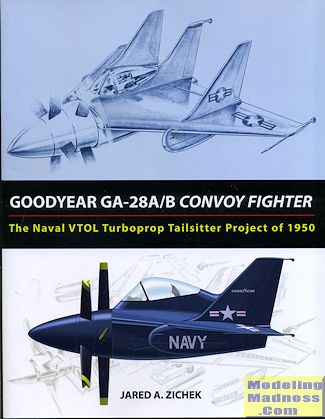 During the
last years of WWII and into the 1950s, the pace of aviation development was
staggering. Advances were coming so quickly that what was top of the line one
year, was nearing obsolescence just a few years later. It was also a time of
innovation where the military was not afraid to try something new and designers
were more than happy to stretch their abilities as well.
During the
last years of WWII and into the 1950s, the pace of aviation development was
staggering. Advances were coming so quickly that what was top of the line one
year, was nearing obsolescence just a few years later. It was also a time of
innovation where the military was not afraid to try something new and designers
were more than happy to stretch their abilities as well.
Such was the case of the Convoy Fighter. This was a plan to
allow ships in a convoy to carry a plane or two for self protection against
enemy bombers without the requirement for a large and expensive aircraft
carrier. The specifications called for a turboprop powered aircraft that could
land and take off vertically without the need for complex handling apparatus. It
should also be able to operate from a ship that was moving and so had to be able
to handle not only fore and aft movement but also side to side motion. These are
the motions that make most first time voyagers sea-sick.
Proposals were submitted by several companies and two were
chosen. These became the Convair XFY-1 and the Lockheed XFV-1. Both of these
planes flew, though only the Convair entry was able to take off and land
vertically. The main issue was the lack of power from available turboprop
engines and the difficulty of landing.
Goodyear submitted their proposal, the GA-28, itself a short,
stubby, delta wing aircraft with something the other two did not have, and that
was the capability of operating from normal runways. This additional feature
came with a weight penalty and in the end, that was the main reason it was not
chosen to be built. Interestingly, its chosen engine, the double-Mamba, went on
to provide sterling service in the Royal Navy's Gannet ASW aircraft.
In this book, the author covers every known aspect of the
GA-28 series and includes a wealth of engineering drawings of the aircraft in
question. There are also artists impressions of these aircraft as well as full
color profiles of what might have been. It makes for a fascinating look into
what might have been and sheds some light on a little known aviation project.
September 2015
My thanks to
www.retromechanix.com for providing the review
sample. You can get yours
here.
If you would like your product reviewed fairly and fairly quickly, please contact
the editor or see other details in the Note to
Contributors.
Back to the Main Page
Back to the Books Index
Page
 During the
last years of WWII and into the 1950s, the pace of aviation development was
staggering. Advances were coming so quickly that what was top of the line one
year, was nearing obsolescence just a few years later. It was also a time of
innovation where the military was not afraid to try something new and designers
were more than happy to stretch their abilities as well.
During the
last years of WWII and into the 1950s, the pace of aviation development was
staggering. Advances were coming so quickly that what was top of the line one
year, was nearing obsolescence just a few years later. It was also a time of
innovation where the military was not afraid to try something new and designers
were more than happy to stretch their abilities as well.